L2-Mechanisms of Respiration
ANATOMY OF RESPIRATORY SYSTEM
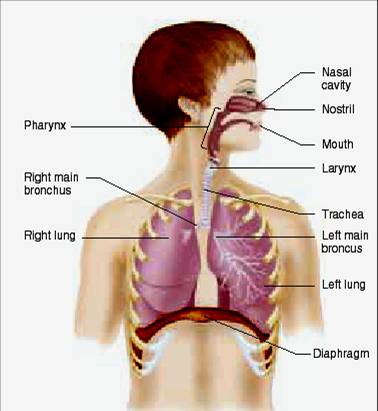
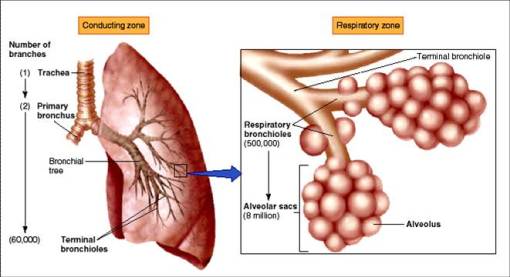
COMPONENT OF RESPIRATORY SYSTEM
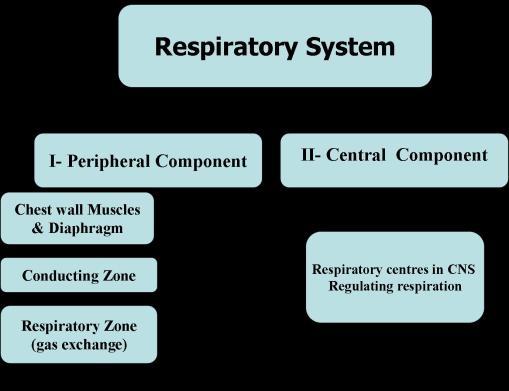
The Main function of the Respiratory system
The Primary function is to obtain oxygen for use by the body’s cells and eliminate CO2 that cells produce.
MECHANISMS OF BREATHING
For pulmonary ventilation to occur there should be a pressure gradient driving air in & out
- The movement of air into & out of the lungs (ventilation) occurs as a result of pressure difference between the alveoli & environment
- The pressure differences in pulmonary system are induced by changes in lung volumes occurring as a result of coordinated movement of diaphragm & ches
- The lung volumes are affected by its physical properties; compliance, elasticity & surface tension
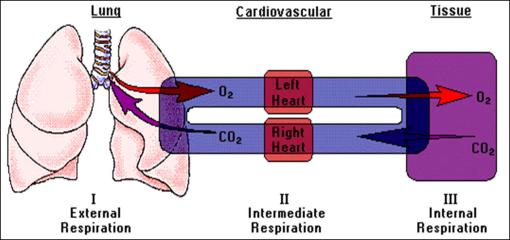
Rest pressures within thoracic cavity
- Atmospheric pressure surrounding the body =760 mm Hg
- Intraalveolar or intrapulmonary pressure: pressure within alveoli =o=atmospheric during rest
- Intrapleural pressure: pressure within pleural sac=subatmospheric= always negative
 Boyle’s Law
Boyle’s Law
•Describing the relationship between volume of gases and its pressure stating that:
P1xV1=P2XV2
•So within a chamber, as the volume of the chamber is increased the pressure of the gas within it decreases & vice versa
So as the volume of chest & lungs change during breathing this leads to change in pressure within the lungs leading to movement of air in & out
Breathing Cycle
-Normal adult breathes about 12-16 breaths or cycles/min
-Breathing cycle (3.7 sec) includes 2 phases followed by a pause:
- Inspiration; the flow of air from atmosphere into the lungs
- Expiration; the flow of air from lungs to outside
- Expiratory pause
Mechanism of Inspiration
Normal Quiet inspiration
-is an active process; caused by contraction of the diaphragm & external intercostal muscles
- The Diaphragm is the main muscle of inspiration (75% of inspiratory act) → increase in the vertical diameter of thoracic cavity
- External intercostal muscles contraction → increase in the lateral dimensions of thoracic cavity

Forced Inspiration
•Forced inspiration is aided by accessory muscles of inspiration;
- sternomastoid (elevation of the sternum)
- scalene muscles (elevation of upper ribs)


Mechanism of Expiration
Normal Quiet expiration
is a passive process occurring as a result of:
- relaxation of muscles of inspiration
- Elastic recoil of the lungs
- Descent of thoracic cage by gravity
•Leading to decrease in volume of the lungs → increase in intrapulmonary pressure to be greater than atmospheric pressure (+1mm Hg) → pressure gradient → rush of air out of the lungs
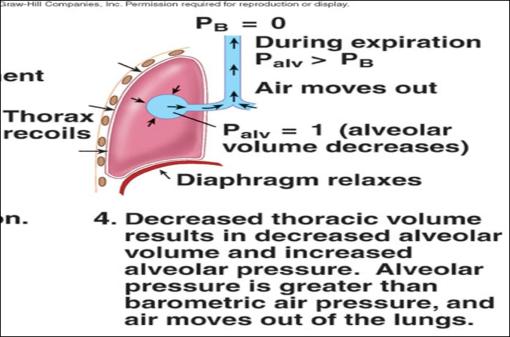
Forced expiration
is an active process caused by contraction of muscles of forced expiration;
- abdominal muscles
- internal intercostal muscles
•Contraction of these muscles leads to greater decrease in lung volume and hence greater pressure gradient between intrapulmonary & atmospheric P leading to more air moving out of the lungs
Pressure Relationship during Breathing Cycle

1) Intrapleural pressure (Intrathoracic pressure)
-It is the pressure within the pleural cavity.
-It is always negative which acts as a suction to keep the lungs inflated.

-etiology of the negativity of the intrapleural cavity
- Surface tension of alveolar fluid
- Elasticity of lungs
- Elasticity of thoracic wall
- Minimal volume of air & fluid in pleural cavity
-changes of intrapleural pressure during Eupnoea
- As the thoracic wall moves outward during inspiration, the intrapleural pressure becomes more negative.
- As the thoracic wall recoils during expiration, the pressure returns to normal (756 mmHg)
-IPP values
- -4 mm Hg at end of normal expiration.
- -7 mm Hg at end of normal inspiration.
- -3o mm Hg during forced inspiration
- +30 mm Hg during forced expiration
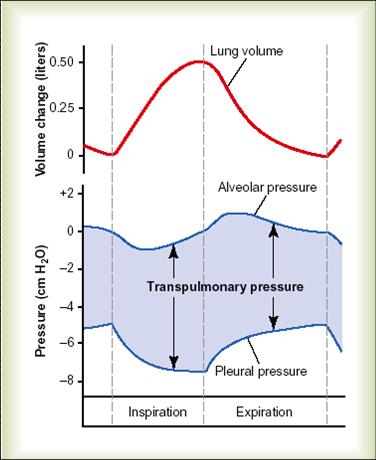
-Significance of negativity if IPP
1-It helps expansion of the lungs.
2-It helps also:
a-Venous return to the heart
b-Lymphatic drainage
c-Pulmonary blood flow in the pulmonary vessels.
FACTORS OF NORMAL RESPIRATION
1) Elastic recoil of the lungs
•It is the tendency of the lung to return to its original volume when stretched
•Contributes to occurrence of expiration & to negativity of IP
•Due to:
1- elastic fibres; elastin + collagen fibres (responsible for 1/3 of recoil)
2- surface tension of fluid lining alveoli (responsible for 2/3 of recoil)
•This tendency to recoil (tendency to resist distension) is reduced by presence of Surfactant
2) The lung surfactant

•It is a lipoprotein substance secreted by alveolar epithelium into the alveoli.
•It decreases the surface tension of the fluid lining the alveoli
•It is secreted among the fluid molecules, so decreasing the attraction between them and lowering the surface tension
•physiological significance of surfactant
- Prevention of collapse of small alveoli especially during expiration.
- Decrease of muscular effort needed to ventilate the lungs.
- It has an immune effect to protect the lugs against invaders
•surfactant decreases in the following conditions
1-Respiratory distress syndrome (hyaline membrane disease)
2-Cigarette smoking.
3-After cardiac surgery.
4-Elective cesarean section
3) Compliance
•Compliance is a measure of the ease of inflation of the lungs (measure of distensibility)
•Measured as the change in lung volume for a certain change in transpulmonary pressure (alveolar P-IPP) ; C= ΔV/ ΔP
•When a small change in pressure causes a large change in volume, this is expressed as a highly compliant lung
•Lung compliance =200 ml/ 1cm H2O pressure
•Lung + chest compliance = 130 ml/cm H2O
•Factors affecting Compliance
1) Factors in the lungs:
- Conditions ↑ surface tension → ↑elastic recoil of the lung (decreasing lung expansion) →↓ complianc
- Conditions ↓ elastic tissues of lung as in lung fibrosis → ↓compliance
2) Factors in the chest;
Compliance is decreased by
- Chest deformities
- Bone diseases
- Muscle diseases
- Obesity
COMPLICATION DUE RESPIRATORY IMPAIRMENT
Pneumothorax
-It is the collapse of the lung due to a puncture into the pleural cavity of chest wall or the lungs.
-The collapse results from air entering the pleural cavity, as it moves from high pressure to low pressure.
-If one lung is punctured, the other lung is unaffected.
This is because the lungs are completely separate from one another.
Each lung is surrounded by its own pleural cavity and pleural membrane. Therefore, changes in the intrapleural pressure of one lung is independent of the other lung.

-Types of pneumothorax
1-Closed:
When there is a small hole in the thoracic wall or the lung (spontaneous). The air will be gradually absorbed and the IPP returns negative
2-Open:
When the hole is large. The IPP is atmospheric.
3-Valvular (Tension):
When a flap of tissue over the hole acts as a valve that allows air entry during inspiration but prevents its escape during expiration. The IPP is positive and the lung is severely collapsed.



pergh, berpinar mata aku menengoknya~
selamat menjadi doktor!
aku lambat lagi a bro~
wah,x sangka x-classmate dtg baca blog aku,huhu.. ala,lmbt setahun jer,huhu… apa crita KMB??? Nnt fly ke mana??
Heheh, saja jalan-jalan. Ang blajaq dalam English ek? Info padat, buleh lemas aku dalam lautan ilmu kat sini (kinayah la plak =p )~
InsyaALLAH, aku cuba manfaatkan apa yang ada dalam blog ang nih~
mana setahun bro~
ang dah abih housemanship, aku baru merangkak masuk spital~
KMB? heheh, banyak cerita~
ada sikit jer yang aku citer kat blog aku~
nak tahu lebih lanjut, kalo aku ada kelapangan, kita sembang~
Lama x sembang ngan ang~
Fly ke mana? heheh, doakan aku pass program persediaan ni~
insyaALLAH, UK or Ireland~
kalo x dapat, maybe New Zealand~
mana2 pon aku x kisah~
Nafeez nak g India dah~
2 Oktober nih, sehari seblom sambutan hari lahir aku~ huhu~
ang bila balik Malaysia?
Dah balik habaq la nah, nanti kita beraya sama-sama!
haha,xde pape sgt dlm blog…cuma edit beberapa slide masuk dlm satu post,just alternative study utk cuti 3 bulan yg memalaskn ni,haha…
aku dh balik ar,dh sbulan kt msia,skang dok kt Tmn Maluri,KL..tgh attach kt Hospital Ampang,dh 4 minggu…
n kitorg blaja 6 tahun,so nnt gap just stahun jer,dpt la aku jadi senior housman utk ko nnt,haha..
wei,add aku dlm ym-ak47boyz90@yahoo.com….
jom sembang,n plan pape reunion k….